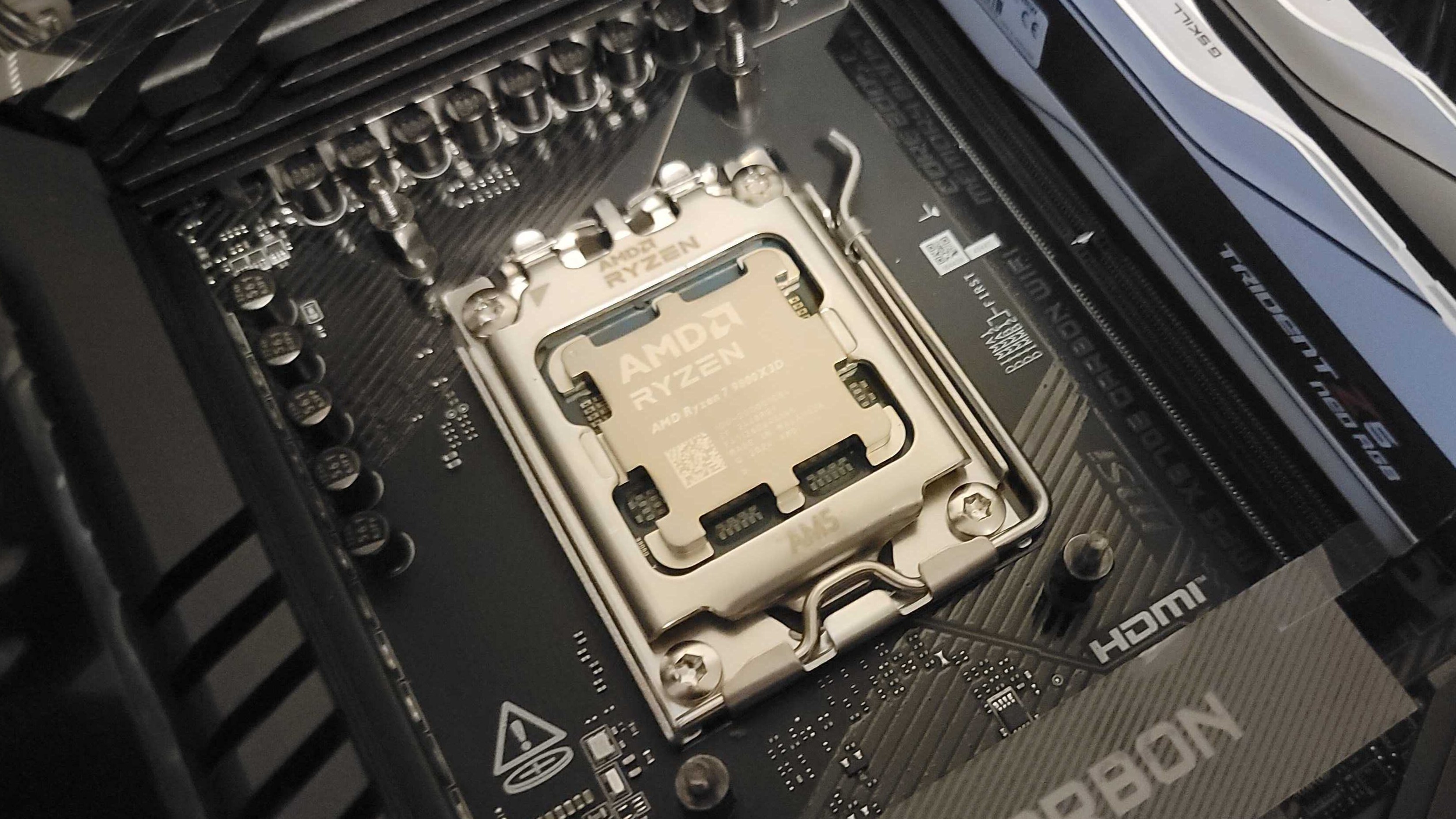Why you can trust Tom's Hardware
AMD Ryzen 7 9800X3D Productivity Benchmarks — The TLDR
We boil down productivity application performance into two broad categories: single-threaded and multi-threaded. These slides show the geometric mean of performance in several of our most important tests in each of these categories, but be sure to look at the expanded results below for more granular analysis.


AMD's 3D V-Cache chips have long delivered exceptional gaming performance but lagged in productivity workloads due to the lower clock rates borne of the thermal issues associated with the L3 chiplet. Reducing that disparity was one of the primary motivators for the new design, and here we can see the payoff.
The 8-core Ryzen 7 9800X3D is 4% faster in multi-threaded workloads than the 8-core Ryzen 7 9700X, which leverages a traditional CPU design. That's quite an accomplishment, and it demonstrates that AMD is putting the extra 15W of TDP headroom over the 9700X (tested in 105W mode) to exceptionally good use. We also see a big 34% increase in multi-threaded performance over the prior-gen 7800X3D.
The competing Intel chips are much faster in threaded work, though. The Core i9-14900K is 41% faster in threaded workloads, while the Core Ultra 9 285K is a whopping 64% faster. Keep in mind that the 14900K currently costs less than the 9800X3D.
The Ryzen 7 9700X has a 300 MHz higher boost clock rate than the 5.2 GHz Ryzen 7 9800X3D, so it isn't surprising to see the former take a ~3% lead in single-threaded work, a trend that you'll see repeated throughout the benchmarks below. While the Ryzen 7 9800X3D has made big generational improvements — it's 14% faster than the 7800X3D in single-threaded work — it still lags the competing Intel chips by significant margins. The Core Ultra 9 285K is 13% faster in single-threaded work, while the Core i9-14900K is 10% faster.
The Ryzen 7 9800X3D delivers truly exceptional gaming performance, but it's important to remember that similarly-priced processors provide much more performance in productivity work, so you should buy based on your priorities. You'll notice that the Ryzen 5 5700X3D, which delivers absolutely phenomenal performance for its price point in gaming, suffers tremendously in the application benchmarks due to its aging Zen 3 architecture, so remember to proceed with caution when selecting these chips over more well-rounded competitors. They truly are specialist chips for gaming.
Rendering Benchmarks — AMD Ryzen 7 9800X3D


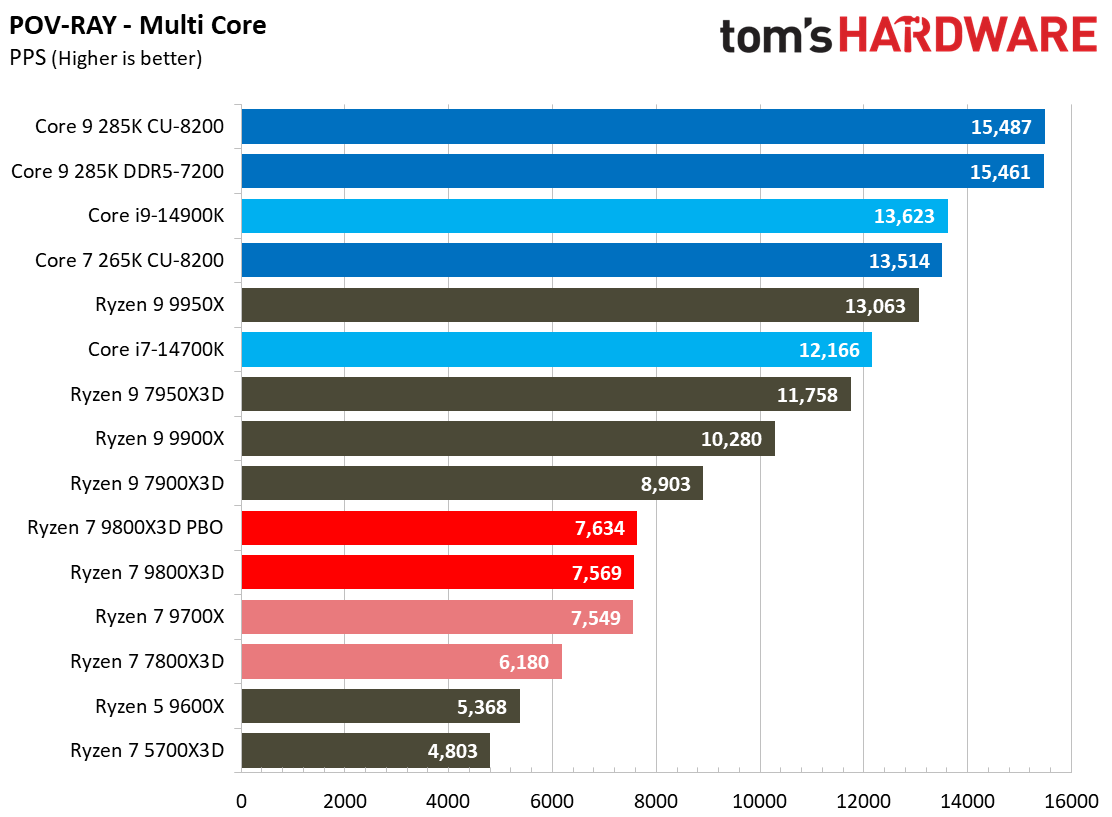





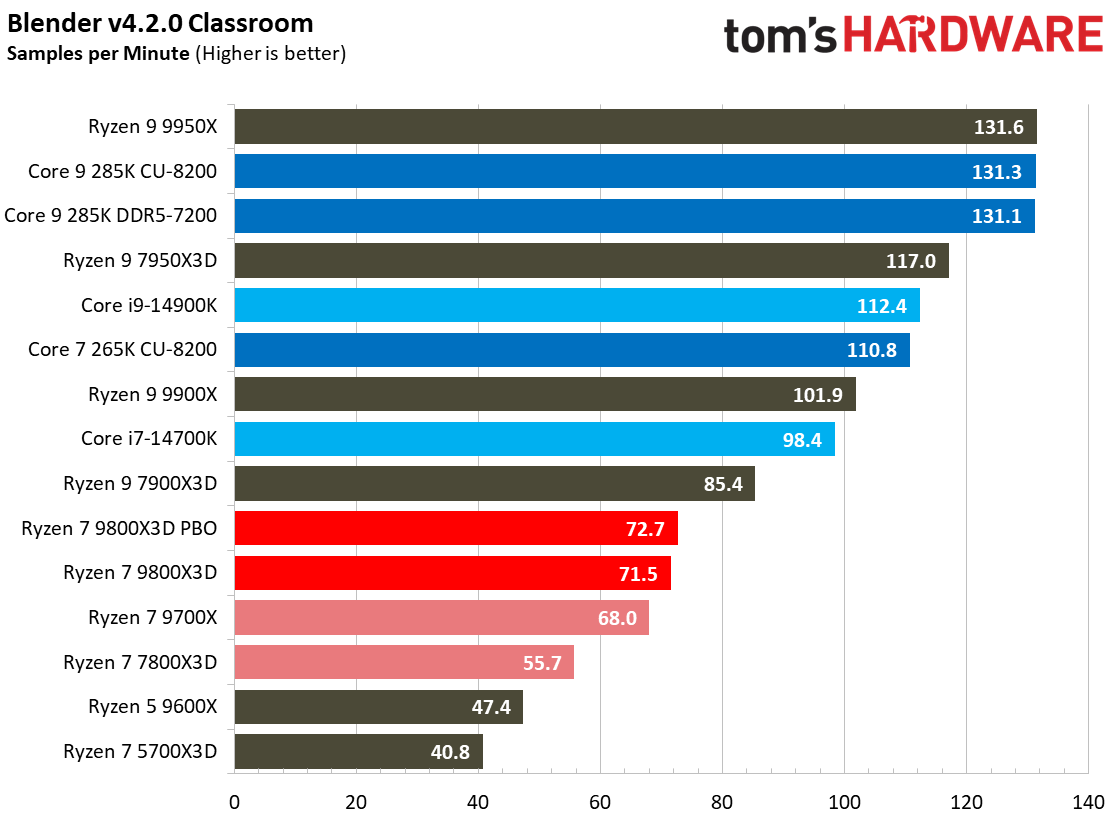




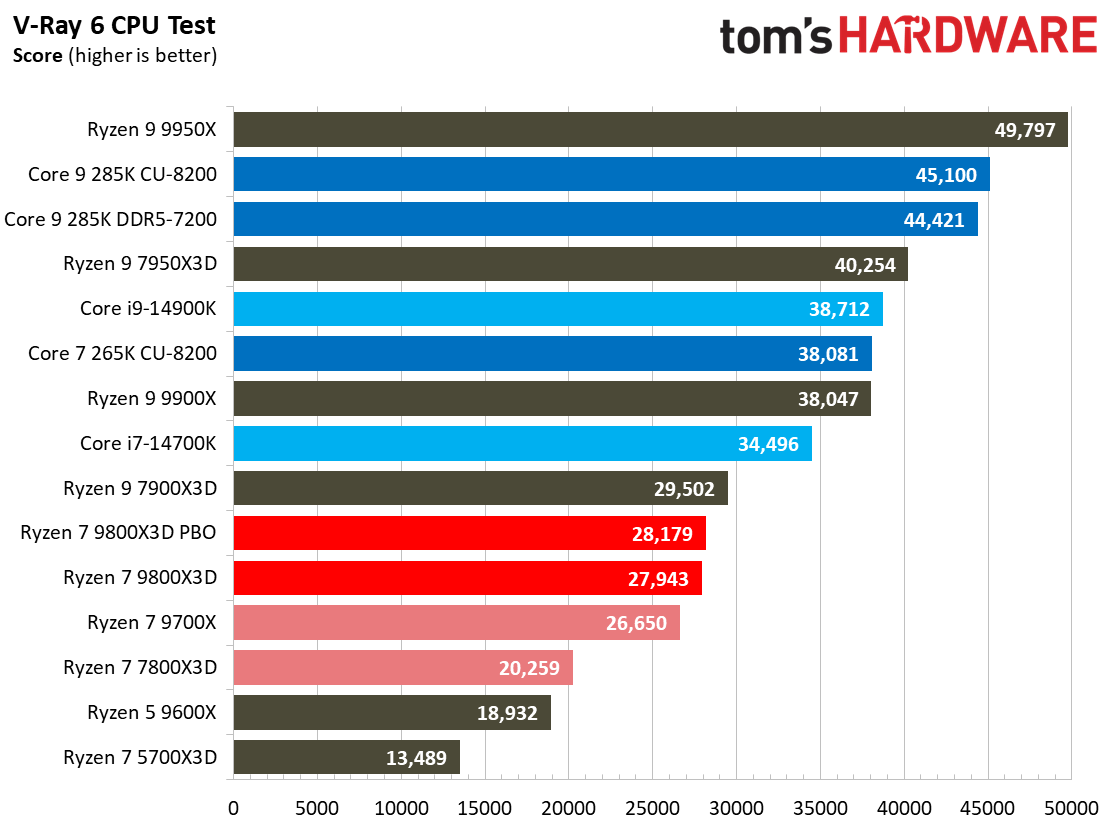


Intel has made strong gains with Arrow Lake, as we can see throughout this series of benchmarks. The increased throughput from the CUDIMMs doesn't often make a big impact, so unless there's a pricing benefit or future firmware updates that change the situation, regular DDR5 DIMMS seem just fine.
We see some remarkable gains in threaded workloads for the 285K, with performance in Cinebench 2024, POV-Ray, C-Ray, and Luxmark all taking giant strides forward. However, the AMD Ryzen 9 9950X remains strong in several tasks, like Embree, V-Ray 6, Blender, and Corona.
Encoding Benchmarks — AMD Ryzen 7 9800X3D



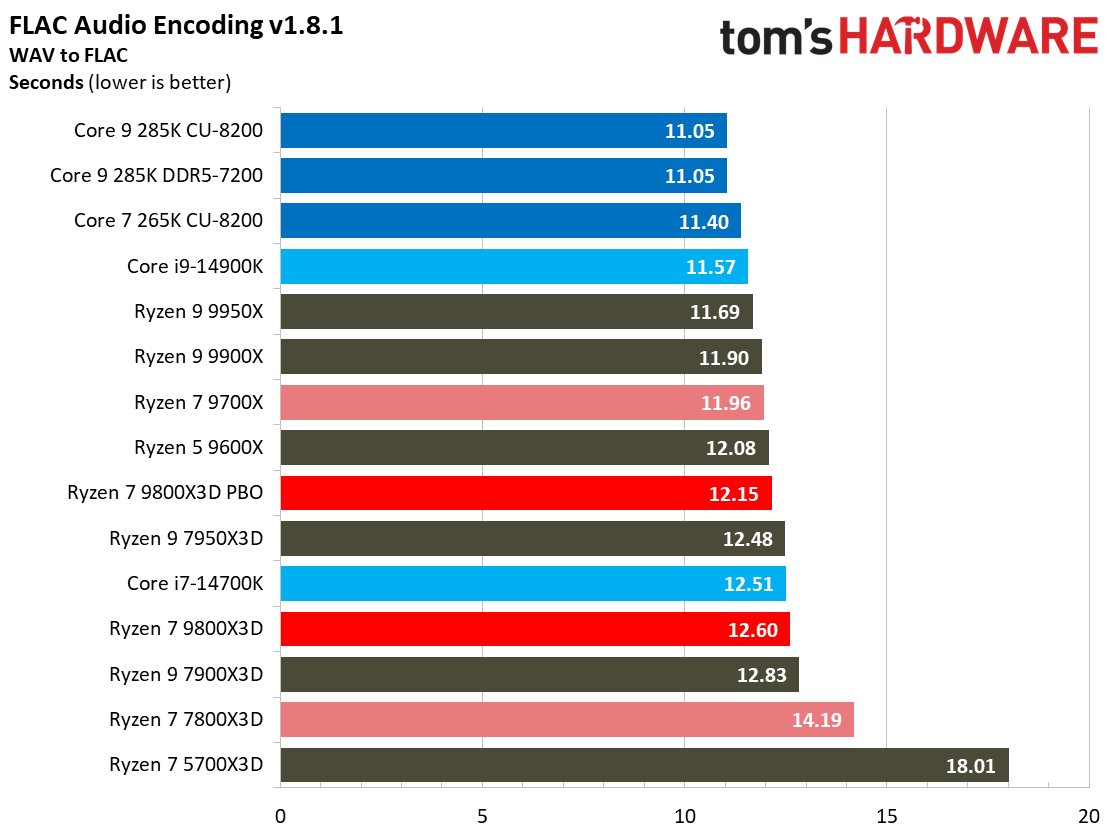






Most encoders tend to be either heavily threaded or almost exclusively single-threaded — and it takes an agile chip to master both disciplines. Handbrake, SVT-HEVC, and SVT-AV1 serve as our threaded encoders, while LAME and FLAC are indicative of how the chips handle lightly-threaded engines.
Adobe Photoshop, Premiere Pro, DaVinci Resolve — AMD Ryzen 7 9800X3D




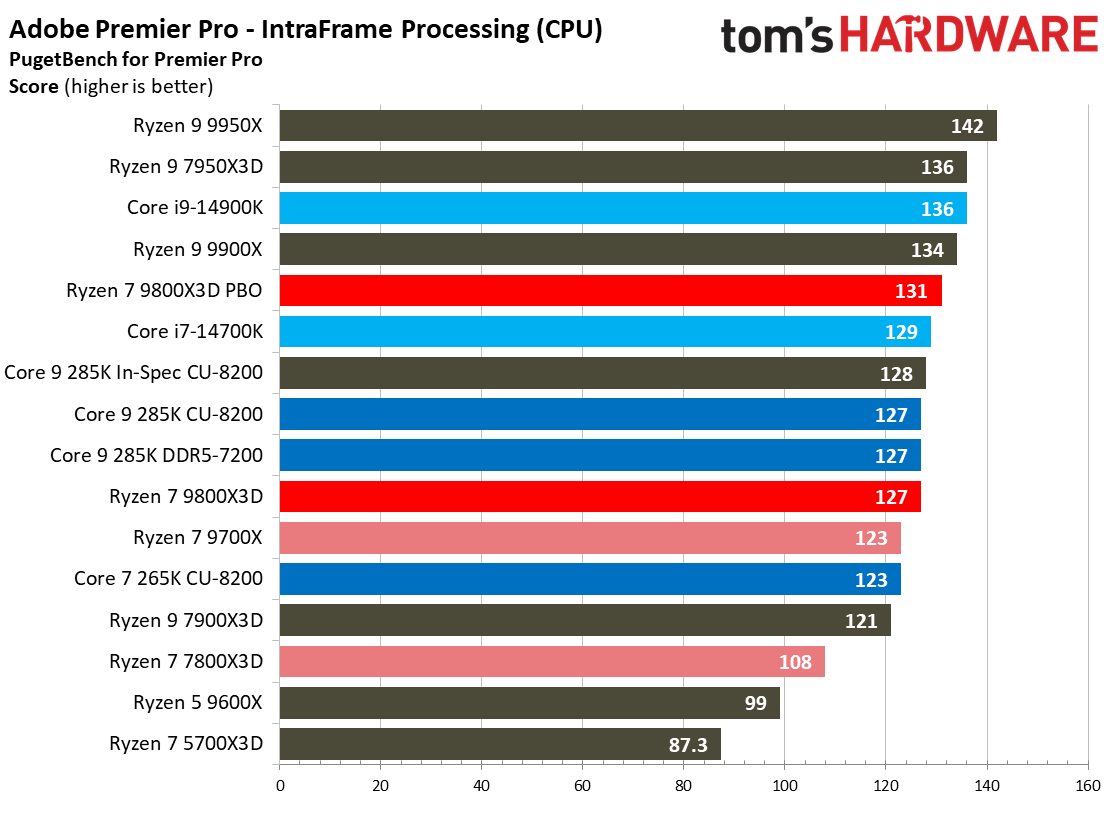
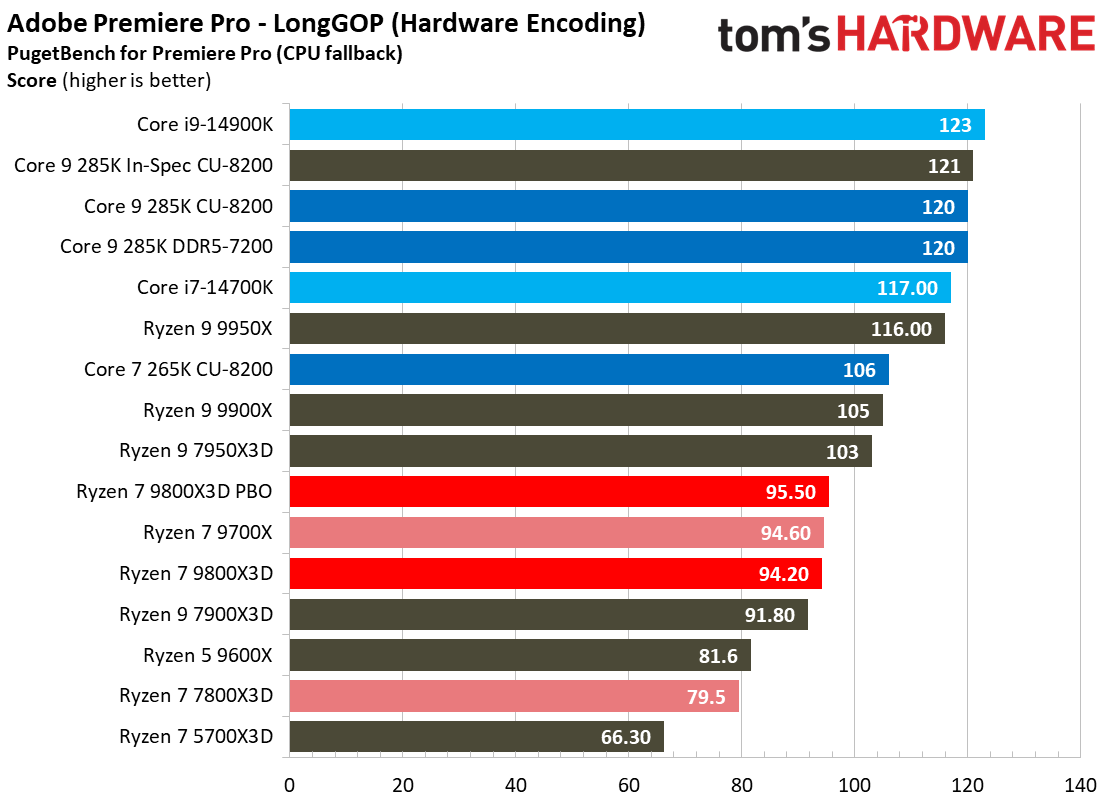





The PugetBench for Creators suite is a wonderful tool for benchmarking multiple types of Adobe applications, not to mention DaVinci Resolve. We used the benchmark for Photoshop, Premiere Pro, and DaVinci workloads.
Web Browser, Office Benchmarks — AMD Ryzen 7 9800X3D




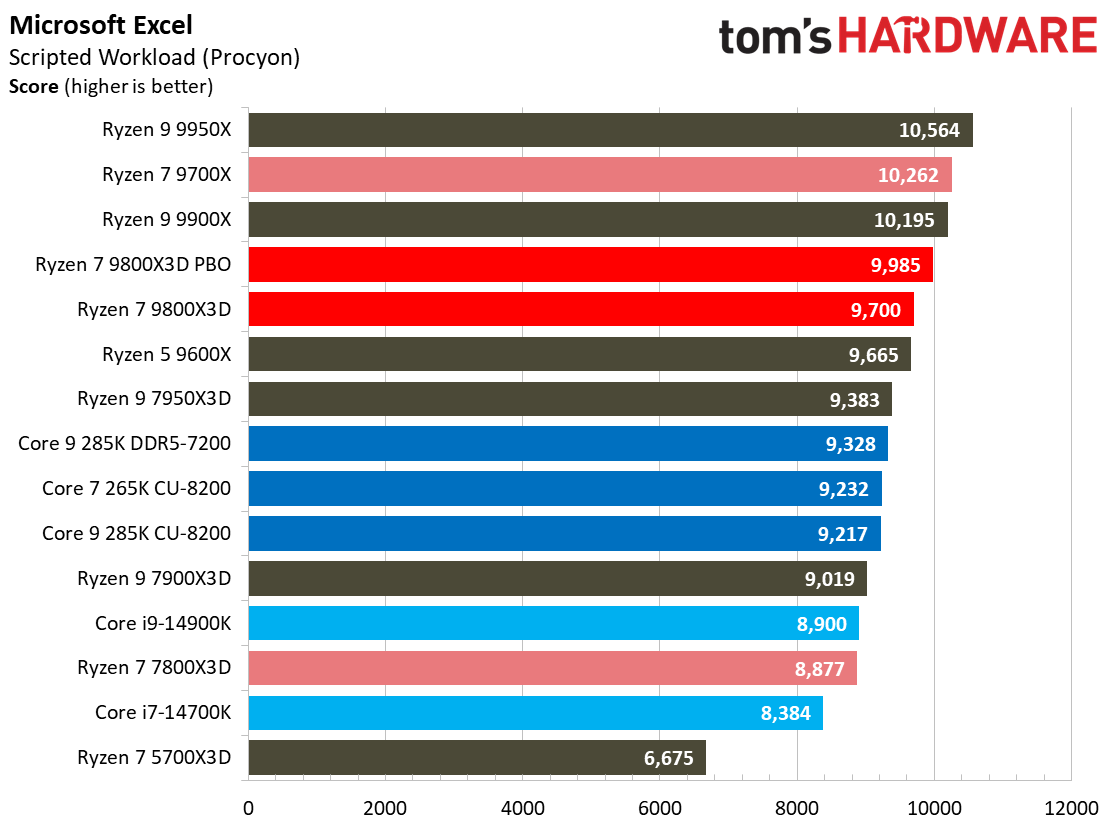


Compilation, Compression, AVX, Chess Engines, Others — AMD Ryzen 7 9800X3D






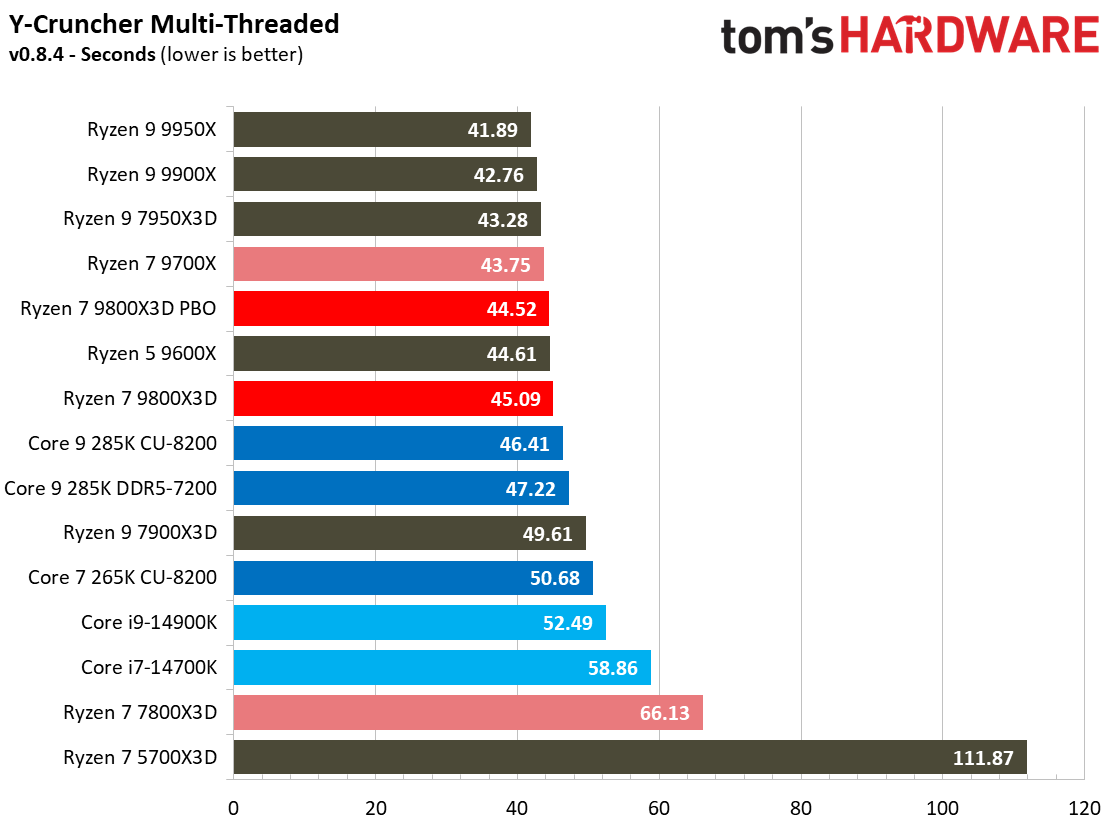








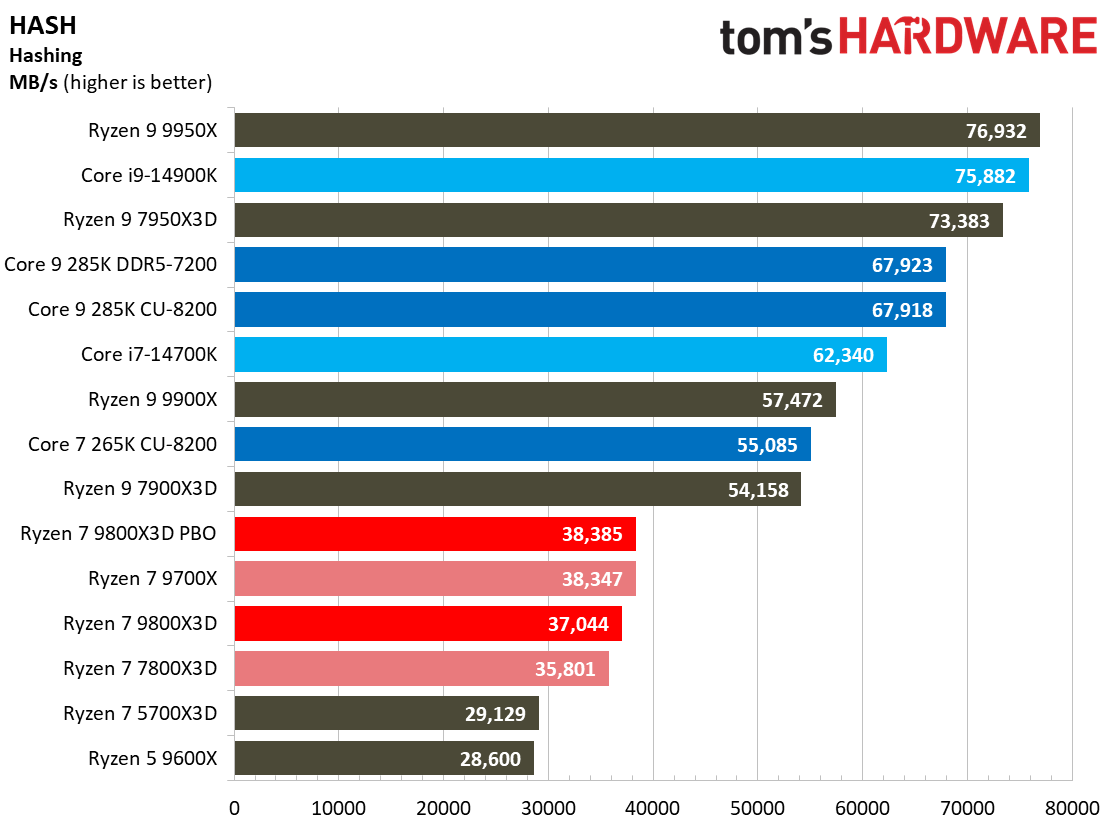
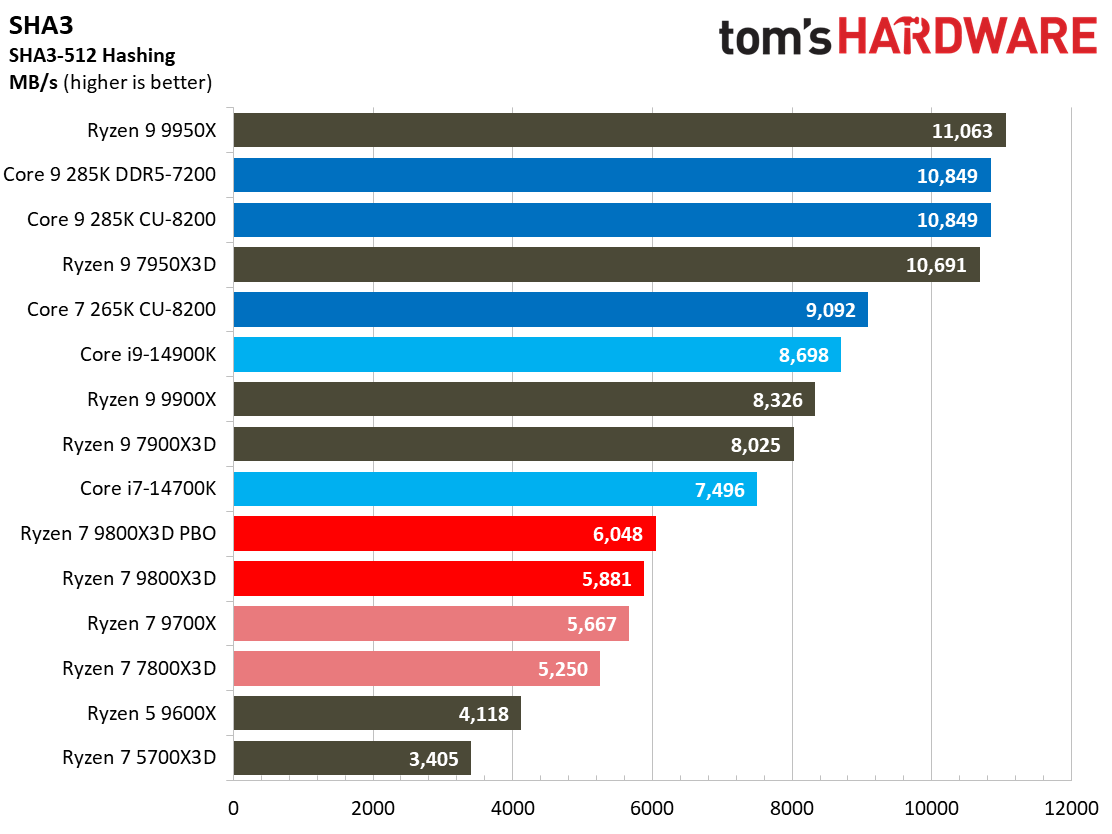


This selection of tests runs the gamut from massively parallel molecular dynamics simulation code in NAMD to compression/decompression performance.
Y-cruncher computes Pi with the AVX instruction set, making for an exceedingly demanding benchmark. This benchmark was recently updated with specific tuning for AMD's AVX-512 implementation. The new code delivers a big boost to Ryzen. Intel's new chips make big strides in this benchmark over the prior generation, but they only support AVX-256 natively, ultimately giving AMD an easy win.
Intel has historically performed well in compilation tasks, and here we can see the 285K taking back the leadership spot in the LLVM benchmark, albeit by a slim margin. The NAMD simulation code benchmark finds the 285K making a much more definitive claim for leadership.
Geekbench 6, Geekbench AI — AMD Ryzen 7 9800X3D
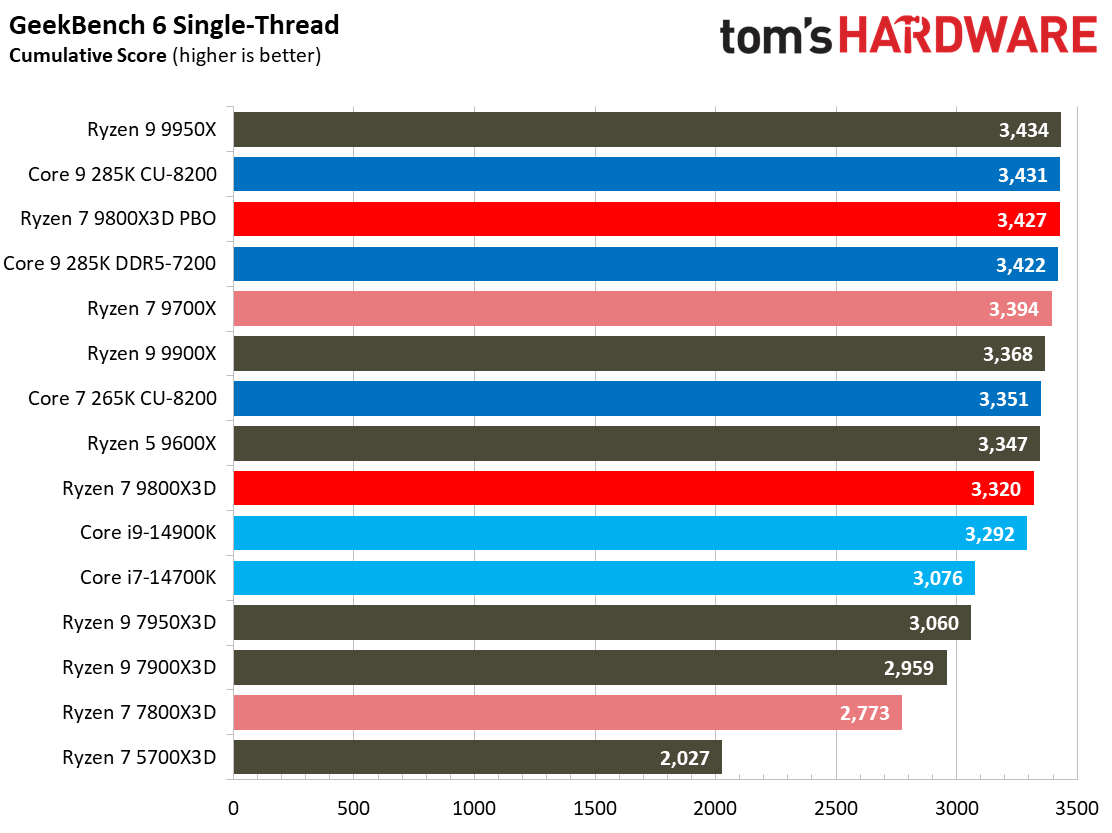



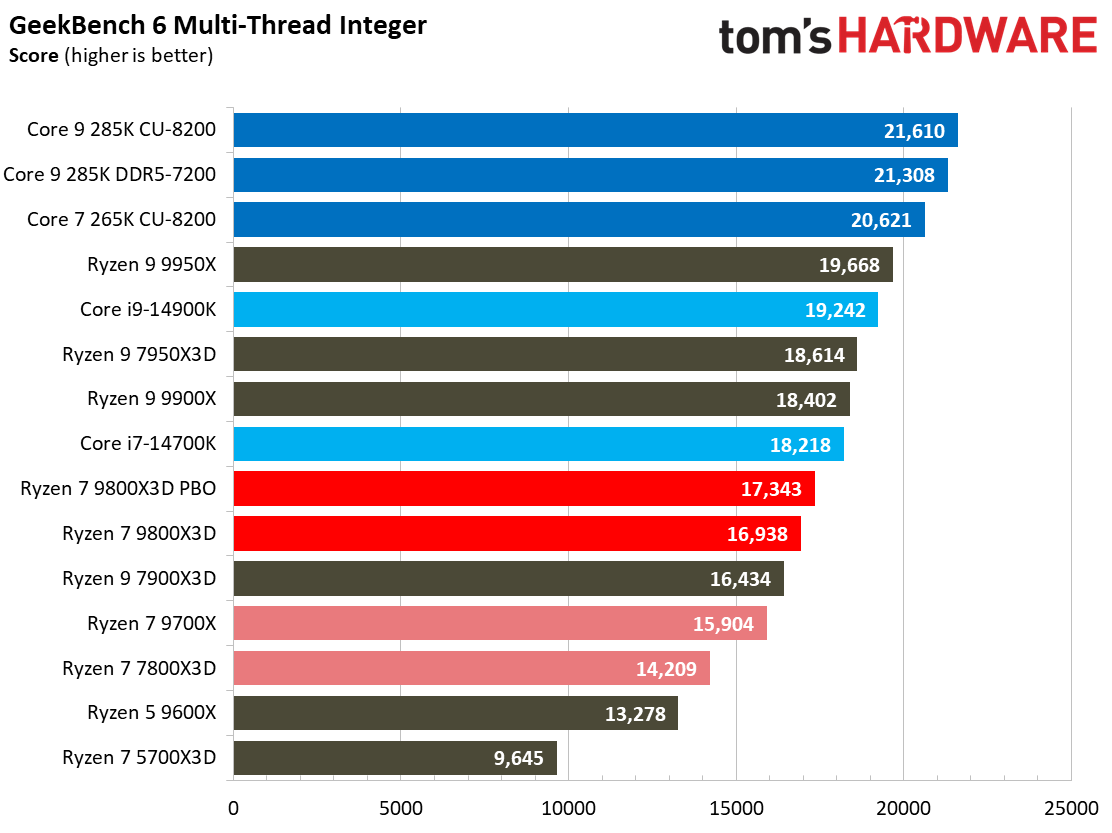



The GeekBench AI results in the slide deck above show performance with the workload running on the CPU cores via OpenVino and ONNX. Only two CPUs in this group have in-built NPUs — the Core Ultra 9 285K and Ultra 7 265K — making them the only processors capable of running the workload on a dedicated NPU. Given that the NPU is focused on low-power inference tasks, the results are impressive relative to the performance when the workload executes on the CPU cores.
Get Tom's Hardware's best news and in-depth reviews, straight to your inbox.
| Tom's Hardware | FP32 | FP16 | Quantized (typ. INT8) |
| Core Ultra 9 285K NPU - ONNX | 5038 | 2119 | 7056 |
SPECworkstation 3.1 — AMD Ryzen 7 9800X3D






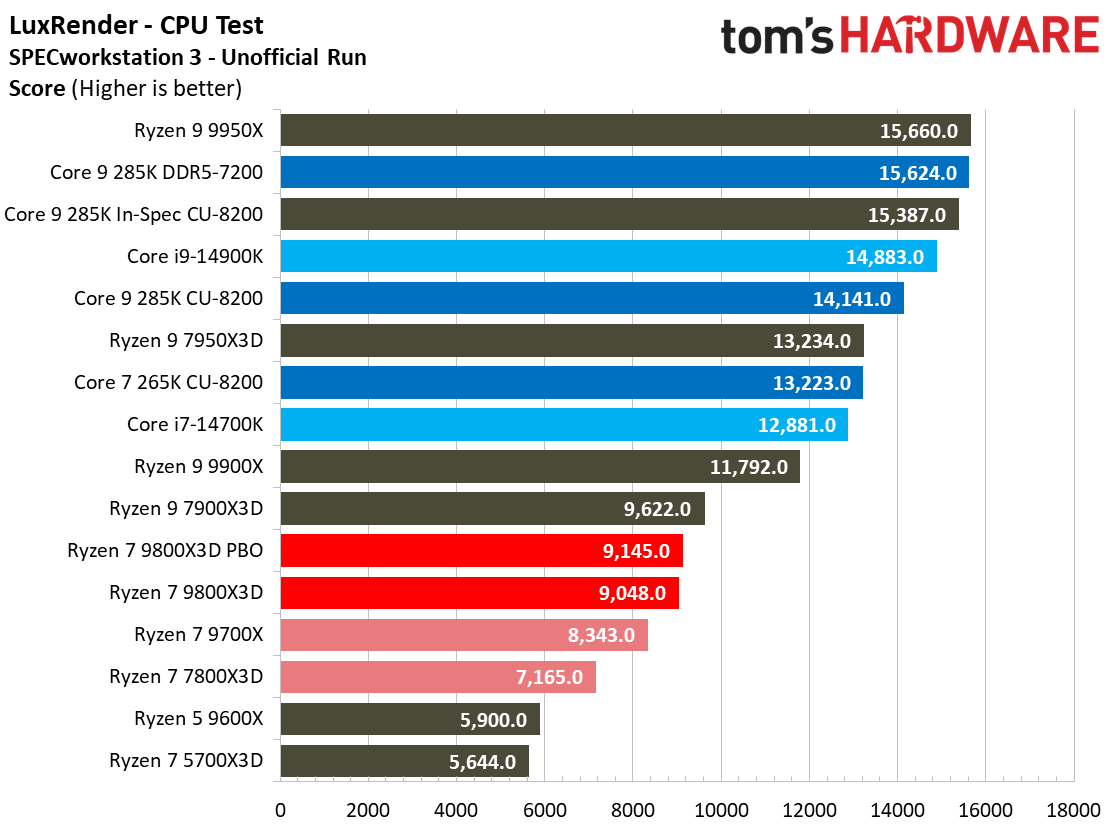













The SPECworkstation 3 benchmark suite is designed to measure workstation performance in professional applications. The full suite consists of more than 30 applications split among seven categories, but we've narrowed the list to tests that largely focus on CPU performance. We haven't submitted these benchmarks to the SPEC organization, so be aware that these are not official benchmarks.
- MORE: Best CPUs for Gaming
- MORE: CPU Benchmark Hierarchy
- MORE: AMD vs Intel
Current page: AMD Ryzen 7 9800X3D Productivity Benchmarks
Prev Page AMD Ryzen 7 9800X3D Gaming Benchmarks Next Page AMD Ryzen 7 9800X3D Power Consumption, Efficiency, Thermals, Boost, Test Setup
Paul Alcorn is the Editor-in-Chief for Tom's Hardware US. He also writes news and reviews on CPUs, storage, and enterprise hardware.
-
-Fran- Thanks a lot for the review, Paul.Reply
Calling this a (gaming) bloodbath is being mild. Holy cow...
"How screwed is Intel after this?
Yes"
EDIT: Thanks Jarred for the YT side as well! I was thinking if you were going to do it again :D
Regards. -
ingtar33 christ, AMD really was understating how good a gaming cpu this was.Reply
what a beast. +30% fps gain going AMD x3D over intel. It's like 2012 all over again, only instead of intel styling on amd it's amd styling on intel. -
YSCCC Now this is seriously tempting for the gaming only PC for power usage and performance. and it isn't bad if occasionally do production usage eitherReply -
ingtar33 Reply
I think a 30% fps increase team red over blue would make it so that you'd need some serious productivity reasons to even consider intel at this point. furthermore the 9950x exists... and that will out perform intel in gaming as well (not by nearly as much but the productivity will be on par)YSCCC said:Now this is seriously tempting for the gaming only PC for power usage and performance. and it isn't bad if occasionally do production usage either -
Loadedaxe Currently there is no reason to buy Intel, even in productivity. It cost more and performs worse.Reply
Intel....its time to step up. Team Red is winning in everything! -
stuff and nonesense GN comes up with closer numbers 7800x3d vs 9800x3d but still significantly quicker. For gaming if you have the cash budget it’s pretty much the only sensible choice…Reply -
TheHerald Is there any chance of putting this into an ITX case with a tiny pure lock LP type of cooler or the increased power draw makes this a nogo? Kinda thinking of pulling the trigger.Reply -
dalek1234 Have we ever seen such a gaming performance uplift from one gen to the next in the past? I don't recall myself. This is one impressive CPU.Reply
So AMD does a +30% gaming performance improvement from one gen to the next, while Intel does a -5%. How times have changed.
